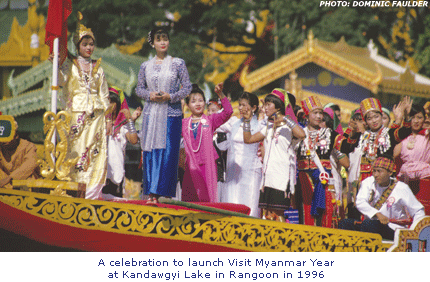Fueling Repression or Assisting the Oppressed?
Burma’s tourism industry has grown in recent years, despite a shaky start, but the debate about whether “to go or not to go” rages on
In November 1996, I was one of fewer than a dozen foreign journalists to witness the extraordinary opening ceremonies for “Visit Myanmar Year,” a promotion that went down as perhaps the greatest marketing flop in the history of world tourism.
 |
In launching their hospitality offensive, Burmese officials had targeted arrivals of more than 500,000 tourists, despite the lack of airline or hotel capacity to handle such a number. They fell short of the target by half, even after extending the campaign for another year.
It was abundantly clear that Burma’s ruling junta had no idea of how to promote a tourism industry. Their doors were certainly not thrown open to the international media to showcase the hermit nation’s many wonders. Most of the journalists there seemed to have arrived by accident.
Indeed, a correspondent from The Economist and I had very nearly been thrown out the day before. We were regarded as dangerous, having just completed an officially sanctioned visit to the controversial Total-Unocal gas pipeline then under construction to Thailand. We were also more than happy to look for some value-added material from one of the world’s most overlooked destinations. Tourism in Burma should, after all, be a huge success story.
Perhaps predictably, Burma’s generals shot themselves in the foot at every opportunity. A group of foreigners attempting a bicycle tour of the hinterland had been arrested and deported as suspected spies. This was in a country where arriving passengers were routinely instructed not to take pictures from the plane windows for national security reasons—as if there was anything sensitive to photograph after more than three decades marching backwards economically.
Some things have changed since then. However badly its own people continue to be treated, Burma is becoming far more visitor friendly, certainly by its own remarkably xenophobic standards. In the 1970s, foreigners were officially unwanted and could only obtain brief transit visas for Rangoon. In the 1980s, seven-day visas were available, but fewer than 40,000 people bothered to make use of them each year.
According to official figures, some 600,000 foreign visitors arrived in 2006, generating more than US $100 million in revenue—a pretty poor return on the $1 billion reportedly invested in tourism from overseas since the industry was “liberalized” in the late 1980s. Providing they are not journalists, most foreigners can now easily obtain month-long visas, but still tourists do not really come in any significant numbers. Arrivals may have actually fallen since the 2005 high of 660,000. Tourism numbers have always been rather suspect, as they often include poorly defined cross-border traffic.
On that hot November morning in 1996, squadrons of ethnic maidens were marched relentlessly around a stadium by a senior army officer barking orders into the PA system. “Visit Myanmar Year” had arrived, and here indeed was the “human zoo” denounced by Aung San Suu Kyi and all the others advocating a tourism boycott of the country.
To the men in khaki, it was “situation normal”—parade-ground tourism courtesy of the same marketing strategists who had attempted to render every guide book obsolete by abruptly changing the English spellings of all major place names, not to mention that of the country itself. To anybody else, the scene that day was utterly bizarre and further evidence of the complete incompetence of the military in all matters social and economic.
More than anything, the spectacle was sad. How could such an obviously rich and vibrant country, with its unique, multiethnic culture, be subjected to such a complete lack of imagination? And why had nobody come? Perhaps because it is very hard to suddenly un-isolate a country.
In early 1994, Singaporean Prime Minister Goh Chok Tong gave a press conference in Rangoon. He was at that time the most senior figure in Asean to have visited Burma, and he made much of the need to break down the country’s isolation. He was, of course, quite right, but much too polite to say outright that Burma had been exceedingly good at closing itself off from the outside world and nothing much else.
Isolation is a risky trait to encourage. Boycott proponents say that tourist dollars subsidize military repression, which includes the use of forced labor in the restoration of major tourist sites. This may well all be true, but it overlooks the fact that the violent repression that occurred in 1988 predated any upturn in tourism.
1 | 2 next page »
